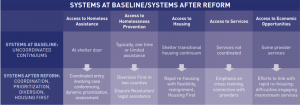CESH expert Debra Rog and colleagues at Westat recently published two reports with key individual-level and systems-level findings as part of her team’s ten-year evaluation of the Family Homelessness System Initiative. The Initiative, funded by the Bill and Melinda Gates Foundation, was launched in 2009 and aimed to reduce family homelessness in the Puget Sound Area by improving the coordination, efficiency, and effectiveness of the family homeless housing and service delivery systems. The evaluation included a Family Impact Study that examined the effects of the systems changes on families served in the system over an 18-month period compared to families served prior to the systems reform. An additional 30-month exploratory evaluation followed-up with a subset of families assigned to rapid re-housing or emergency shelter for their initial assistance.
While approaches varied somewhat among the three counties in the Initiative, all three counties made systems improvements in the areas of coordinated entry, rapid re-housing, and diversion. An overview of systems at baseline and after reform are shown in the graphic below:

Source: A Decade of Innovation: Lessons From the Puget Sound Family Homelessness Initiative, Bill and Melinda Gates Foundation.
Results from the 18-month study provide strong evidence that system changes in the region had a number of positive impacts on the families served. A Housing First orientation—reducing the reliance on shelter and transitional housing in favor of a broader array of assistance that prioritizes housing such as diversion and rapid re-housing—led families to greater and quicker access to permanent housing and more nights in that housing, despite a tightening housing market. Families served after reform were less likely to experience sheltered homelessness in the 18 months following entering the homelessness system than families served prior to reform. In addition, families served after reform experienced greater improvements in employment and income than families prior to reform, although the region’s improving economic conditions might be more responsible for this result than the Initiative itself.
The results from the 30-month evaluation clearly show that communities should adopt a Housing First approach in their homeless service delivery systems to help families access housing as quickly as possible. Further, the evaluation strengthens evidence that housing subsidies are crucial for ensuring housing stability for families. The 30-month follow-up with families assigned to either rapid re-housing or emergency shelter found that rapid re-housing assigned families accessed their housing more quickly and spent more time in that housing than shelter assigned families. Differences in housing stability between the groups was most evident in the first six months after assignment. In both the rapid re-housing and shelter groups, families who got into their own housing early and remained in housing through 18 months were the most likely to be continuously housed for the following 12 months.
The Initiative was less successful in other areas. The evaluation found that there was no change in the rate of returns to homelessness (sheltered and unsheltered) among families who entered housing after systems reform, staying around 10 percent in the one-year period after housing access. Worse yet, families served after reform were more likely to experience unsheltered homelessness, especially while waiting for assistance or if they were unable to access housing. In addition, other outcomes such as parent-child intactness, child absenteeism in school, and the rate of school transitions during the 18 months following receipt of initial assistance in the system did not appear to be affected by the Initiative’s systems reforms.
Debra Rog and her colleagues present a number of implications for homelessness systems, federal and state agencies, and funders from the Family Homelessness System Initiative:
- Prioritize getting families into housing as quickly as possible, as quicker access relates to longer stability.
- Maintain access to shelter separately from coordinated entry to avoid unsheltered homelessness while families wait for other assistance.
- Strengthen ties with employment agencies and work to improve families’ human capital given the strong association of human capital to housing outcomes.
- Bridge the homeless service system with the public housing authorities, recognizing the critical role subsidies play for some families in maintaining their own housing.
- Consider providing additional supports to families who enter coordinated entry with larger numbers of children, histories of homelessness, and recent evictions.
- Reduce any remaining stock of transitional housing and/or consider repurposing it or targeting it to those who might have repeated difficulty accessing housing and return to homelessness. The study found that being in transitional housing significantly delayed families’ time to access housing, and was a key factor related to the trajectory of families not accessing housing at all within 18-months of initial assistance.
To access all of the evaluation reports, as well as view videos and presentations of the findings, which include lessons from government and for providers, please visit: https://local.gatesfoundation.org/events/a-decade-of-innovation-the-puget-sound-family-homelessness-initiative/
